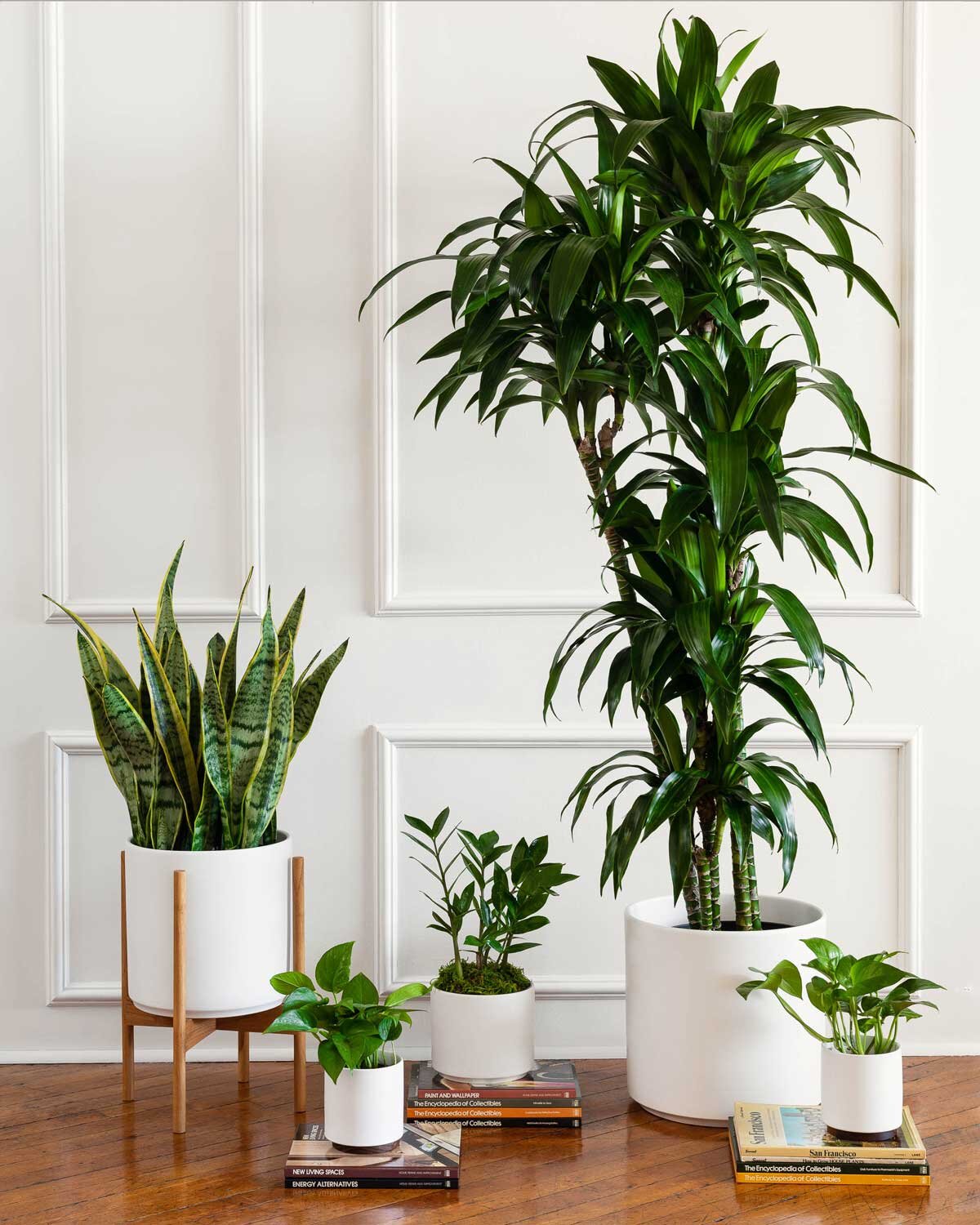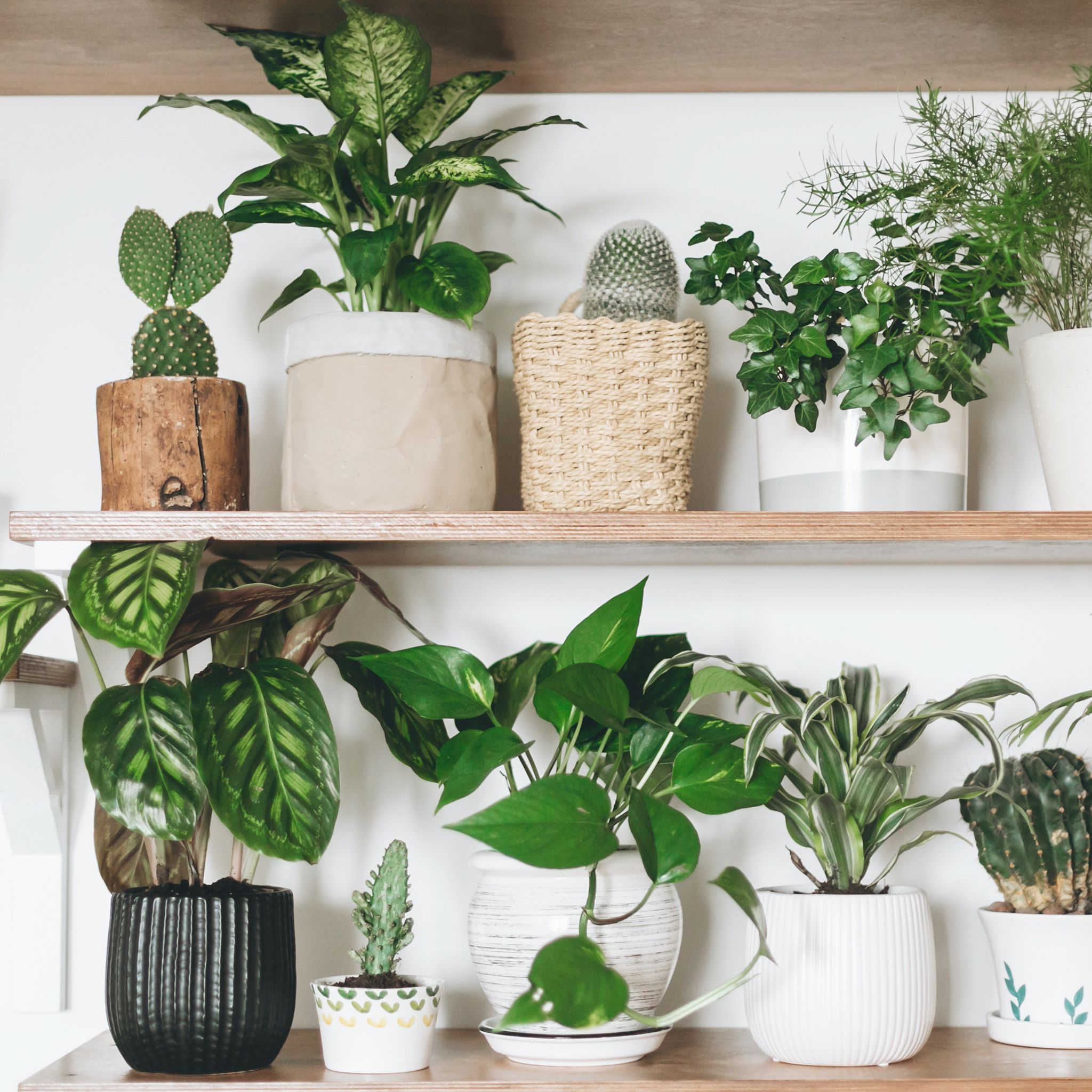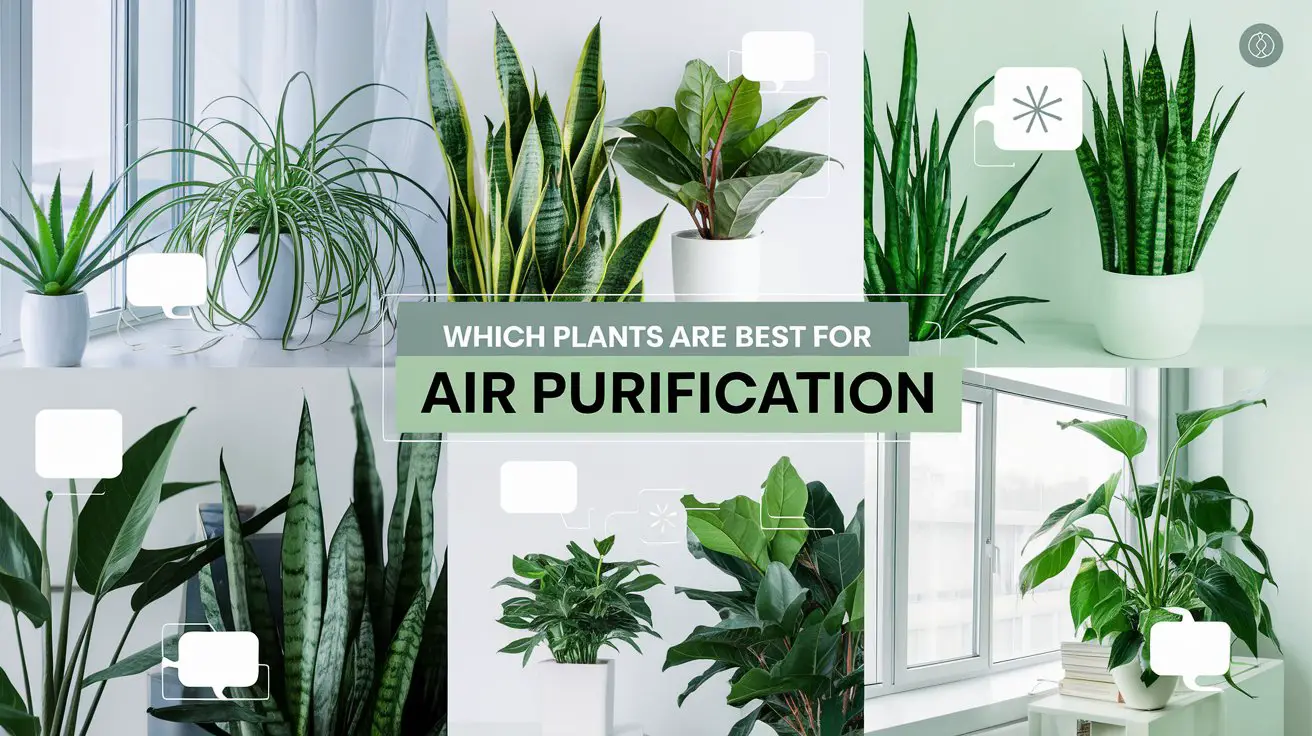The best plants for air purification are the snake plant, spider plant, and peace lily. These plants effectively remove toxins from the air.
Indoor air quality significantly affects health and well-being. Many common household items release pollutants, making clean air crucial. NASA’s Clean Air Study identified certain plants that excel in purifying the air. The snake plant, spider plant, and peace lily stand out for their efficiency.
These plants are easy to care for and thrive indoors. They not only enhance air quality but also add a touch of nature to home decor. Incorporating them into your living space can lead to a healthier environment. Investing in these plants is a simple yet effective way to improve indoor air quality.
Spider Plant
The Spider Plant, also known as Chlorophytum comosum, is a popular houseplant. It’s easy to care for and great for air purification. This plant is ideal for beginners and experienced gardeners alike.
Key Features
- Appearance: Long, arching leaves with green and white stripes.
- Growth: Produces small white flowers and baby plants, known as “spiderettes.”
- Light: Thrives in indirect sunlight.
- Water: Requires moderate watering; do not overwater.
Benefits For Air Quality
The Spider Plant is known for its air-purifying capabilities. It can remove harmful substances from the air.
| Substance | Effect |
|---|---|
| Formaldehyde | Found in furniture and cleaning products. |
| Xylene | Present in paints and solvents. |
| Toluene | Emitted from car exhausts and industrial processes. |
These substances can cause health problems. The Spider Plant helps reduce their levels in your home.
Snake Plant
The Snake Plant, also known as Sansevieria or Mother-in-Law’s Tongue, is a hardy indoor plant. It’s famous for its air-purifying abilities and low maintenance requirements. This plant is perfect for beginners and experienced gardeners alike.
Key Features
- Scientific Name: Sansevieria trifasciata
- Common Names: Snake Plant, Mother-in-Law’s Tongue
- Light: Low to bright indirect light
- Water: Low water needs
- Growth: Slow-growing, can reach up to 2-3 feet
- Temperature: Prefers warm conditions, 60-85°F (15-29°C)
Benefits For Air Quality
The Snake Plant is an excellent air purifier. It removes toxins such as formaldehyde, benzene, and trichloroethylene from the air. NASA’s Clean Air Study has proven its effectiveness.
This plant releases oxygen at night, making it ideal for bedrooms. It improves indoor air quality and helps you sleep better. The Snake Plant is also easy to care for, needing little water and light. This makes it a perfect choice for busy people.
| Toxin | Removed By Snake Plant |
|---|---|
| Formaldehyde | Yes |
| Benzene | Yes |
| Trichloroethylene | Yes |
In summary, the Snake Plant is a top choice for air purification. It is easy to maintain and highly effective at improving air quality. Its unique features make it a must-have for any home.
Peace Lily
The Peace Lily is a popular choice for indoor air purification. It has attractive green leaves and white flowers. This plant is easy to care for and effective at removing toxins from the air. Let’s explore the key features and benefits for air quality.
Key Features
- Scientific Name: Spathiphyllum
- Light Requirements: Low to moderate light
- Watering Needs: Weekly watering
- Temperature Range: 65-80°F (18-27°C)
- Growth Height: Up to 3 feet (90 cm)
- Flowering Period: Spring and summer
Benefits For Air Quality
The Peace Lily is known for its air-purifying qualities. It can remove harmful toxins from the air. The plant targets pollutants like:
- Formaldehyde
- Benzene
- Trichloroethylene
- Ammonia
According to a NASA study, the Peace Lily is highly effective. It improves indoor air quality by absorbing these pollutants through its leaves and roots.
| Pollutant | Effect |
|---|---|
| Formaldehyde | Reduces respiratory issues |
| Benzene | Minimizes cancer risk |
| Trichloroethylene | Decreases liver and kidney damage |
| Ammonia | Lessens eye irritation |
Besides its air-purifying benefits, the Peace Lily also adds aesthetic value. Its white blooms and green leaves brighten any indoor space. This plant is a great choice for homes and offices.
Aloe Vera
Aloe Vera is a popular plant known for its many health benefits. This succulent not only looks great but also helps purify the air. Aloe Vera is an excellent choice for improving indoor air quality.
Key Features
- Scientific Name: Aloe barbadensis miller
- Common Names: Aloe, True Aloe, Burn Aloe
- Light Requirements: Bright, indirect sunlight
- Watering Needs: Low; water every 3 weeks
- Growth Rate: Moderate
- Soil Type: Well-draining, sandy soil
- Temperature Range: 55°F – 80°F (13°C – 27°C)
Benefits For Air Quality
Aloe Vera is effective in removing toxins from the air. It filters out formaldehyde and benzene, commonly found in household products.
| Toxin | Source |
|---|---|
| Formaldehyde | Cleaning products, paints, varnishes |
| Benzene | Detergents, plastics, synthetic fibers |
This plant releases oxygen at night, making it ideal for bedrooms. It improves sleep quality by enhancing air purity. Aloe Vera is also easy to care for, making it perfect for beginners.
English Ivy
English Ivy is a popular plant for air purification. It is known for its beautiful, trailing vines and ability to thrive indoors. This plant not only adds a touch of nature to your home but also helps clean the air.
Key Features
- Scientific Name: Hedera helix
- Light: Indirect sunlight
- Water: Moderate watering
- Growth: Trailing vine
Benefits For Air Quality
English Ivy excels at removing harmful toxins. It can filter out formaldehyde, benzene, and xylene from the air. This makes it great for improving indoor air quality.
Studies show that English Ivy can reduce mold levels. It can also help with allergies by reducing airborne mold particles. This makes it perfect for homes with mold issues.
English Ivy also boosts oxygen levels. This makes your home feel fresher and cleaner. It is especially useful in bedrooms or living areas.
| Feature | Details |
|---|---|
| Scientific Name | Hedera helix |
| Light | Indirect sunlight |
| Water | Moderate watering |
| Growth | Trailing vine |
| Toxins Removed | Formaldehyde, Benzene, Xylene |
| Air Quality Benefits | Reduces mold, boosts oxygen |
English Ivy is easy to care for and hardy. It thrives in indirect sunlight and needs moderate watering. It can be grown in hanging baskets or as ground cover.
Place English Ivy in your home for better air quality. It looks beautiful and helps you breathe easier. This plant is a great addition to any indoor space.
Bamboo Palm
The Bamboo Palm is a popular indoor plant known for its lush, green foliage. This plant is not only beautiful but also effective in purifying the air in your home.
Key Features
- Scientific Name: Chamaedorea seifrizii
- Height: Can grow up to 6-12 feet indoors
- Light Requirements: Thrives in low to medium light
- Watering Needs: Requires regular watering, keep soil moist but not soggy
- Temperature: Prefers temperatures between 65-80°F (18-27°C)
Benefits For Air Quality
The Bamboo Palm is excellent at removing toxins from the air. It helps eliminate harmful substances such as formaldehyde, benzene, and trichloroethylene.
| Toxin | Removed By Bamboo Palm |
|---|---|
| Formaldehyde | Yes |
| Benzene | Yes |
| Trichloroethylene | Yes |
Besides air purification, the Bamboo Palm also increases humidity. This is beneficial for those with respiratory problems.
Here are some additional benefits:
- Reduces airborne mold spores
- Improves overall indoor air quality
- Enhances aesthetic appeal of your home
Planting Bamboo Palm in your home can make a big difference. Its lush leaves and air-purifying qualities make it a top choice for indoor greenery.
Boston Fern
The Boston Fern is a classic choice for air purification. Its lush green fronds add beauty to any space. This plant is also known for its ability to clean the air.
Key Features
The Boston Fern has several distinctive features:
- Appearance: Long, arching fronds with leaflets.
- Size: Grows up to 3 feet tall.
- Light: Prefers indirect sunlight.
- Watering: Needs consistent moisture.
- Humidity: Thrives in high humidity.
Benefits For Air Quality
The Boston Fern is highly effective at improving air quality. Here are some of its benefits:
- Removes Toxins: Cleanses the air of formaldehyde and xylene.
- Improves Humidity: Adds moisture to dry indoor air.
- Reduces Allergens: Helps reduce airborne dust and allergens.
In summary, the Boston Fern is more than just a pretty plant. It enhances indoor air quality, making your home healthier.

Credit: blog.leonandgeorge.com
Chinese Evergreen
The Chinese Evergreen is a popular choice for air purification. Known for its hardy nature, it thrives in low light and requires minimal care. This makes it perfect for both homes and offices. Let’s dive into its key features and benefits for air quality.
Key Features
- Scientific Name: Aglaonema
- Light Requirement: Low to moderate light
- Watering: Moderate watering, allow soil to dry between watering
- Temperature: Prefers temperatures between 60-75°F
- Growth: Slow to moderate growth rate
Benefits For Air Quality
The Chinese Evergreen is excellent for purifying indoor air. It removes toxins like formaldehyde, benzene, and trichloroethylene. These chemicals are common in household items and can affect health.
| Toxin | Source | Health Impact |
|---|---|---|
| Formaldehyde | Furniture, cleaning products | Respiratory problems |
| Benzene | Paints, detergents | Headaches, dizziness |
| Trichloroethylene | Adhesives, varnishes | Liver damage |
Having a Chinese Evergreen can significantly improve indoor air quality. It acts as a natural air purifier, making your living space healthier.
Golden Pothos
Golden Pothos, also known as Devil’s Ivy, is a popular houseplant. It’s favored for its attractive, heart-shaped leaves and its resilience. This plant thrives in various indoor environments and is particularly known for its air-purifying qualities.
Key Features
- Scientific Name: Epipremnum aureum
- Light: Low to bright indirect light
- Water: Allow soil to dry between waterings
- Temperature: 60-85°F (16-29°C)
- Growth: Can grow up to 10 feet long indoors
Golden Pothos is easy to care for, making it perfect for beginners. It can tolerate low light and irregular watering. The trailing vines can be a beautiful addition to any room.
Benefits For Air Quality
Golden Pothos is renowned for its ability to remove toxins from the air. This plant can help in reducing indoor pollutants. Here is a table detailing the specific toxins it can neutralize:
| Toxin | Effect |
|---|---|
| Formaldehyde | Common in household products |
| Trichloroethylene | Found in cleaners and adhesives |
| Benzene | Present in plastics and detergents |
By removing these toxins, Golden Pothos can improve indoor air quality. This can lead to better health and well-being for your family.
This plant also increases humidity levels, which can be beneficial. Higher humidity can help ease respiratory issues and dry skin.

Credit: www.mashrita.com
Areca Palm
The Areca Palm is one of the best plants for purifying air. Its lush green fronds not only add beauty but also improve indoor air quality.
Key Features
- Scientific Name: Dypsis lutescens
- Common Names: Butterfly Palm, Golden Cane Palm
- Light Requirements: Bright, indirect sunlight
- Watering Needs: Moderate, keep soil moist but not soggy
- Height: Can grow up to 6-7 feet indoors
Benefits For Air Quality
The Areca Palm is highly effective in removing toxins from the air. It can eliminate harmful chemicals like formaldehyde, benzene, and carbon monoxide.
| Pollutant | Reduction Efficiency |
|---|---|
| Formaldehyde | 50% |
| Benzene | 30% |
| Carbon Monoxide | 25% |
Additionally, the Areca Palm releases significant amounts of moisture. This feature helps in maintaining indoor humidity levels, especially during dry seasons.
The plant is also known to produce high levels of oxygen. This makes it ideal for improving the overall air quality in your home.
Place this plant in your living room or bedroom. It will enhance your space while providing cleaner, fresher air.

Credit: www.countryliving.com
Frequently Asked Questions
Which Plant Purifies The Air The Most?
The Spider Plant is known for purifying the air the most. It removes toxins like formaldehyde and xylene.
What Is The Best Plant To Clean The Air In Your Bedroom?
The Snake Plant is the best for cleaning bedroom air. It removes toxins and improves air quality efficiently.
What Plants Are Good For Purifying The Air Quality?
Spider plants, snake plants, and peace lilies improve air quality. Aloe vera, English ivy, and bamboo palm also purify air effectively.
What Plants Are Good For Clearing The Air?
Spider plants, peace lilies, and snake plants are great for clearing the air. These plants remove toxins and improve air quality.
Conclusion
Choosing the right plants can significantly improve indoor air quality. Spider plants, peace lilies, and snake plants are top choices. These plants are low-maintenance and effective at removing toxins. By incorporating these plants into your home, you can enjoy cleaner, fresher air.
Start your indoor garden today for a healthier living space.

My mission is to help you bring the beauty of nature indoors with expert advice, detailed plant care guides, and creative design ideas.




